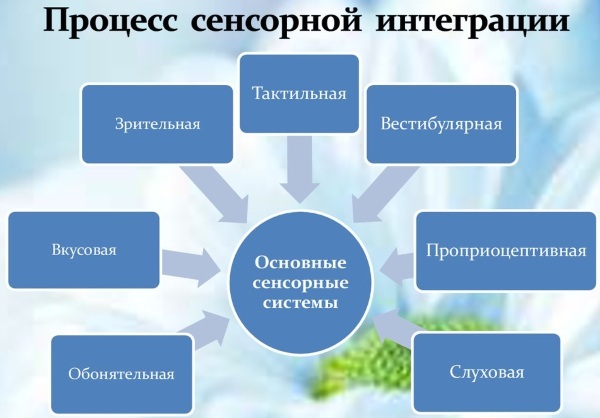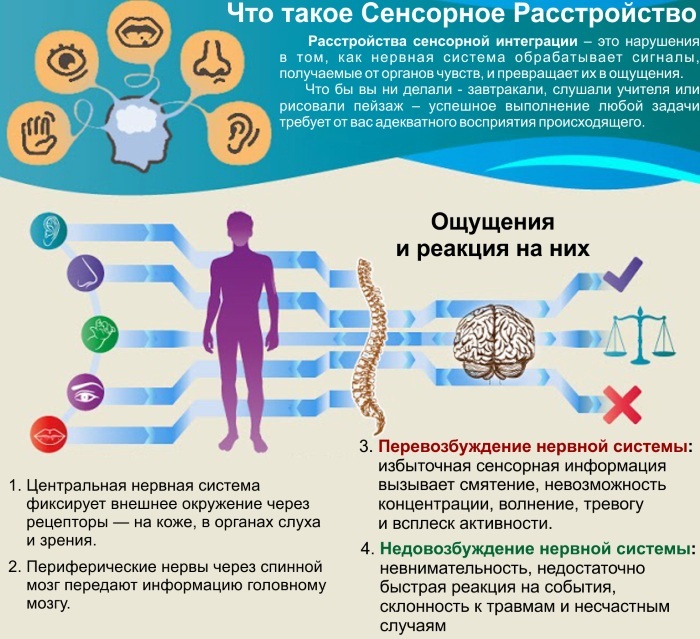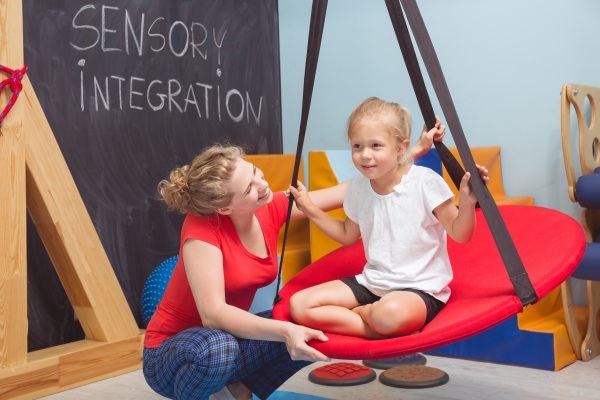Sensory integration refers to the processing of information that the nervous system receives from all senses.
This is necessary to translate data into productive activities. If this process is disturbed, the child develops a developmental lag. Jean Ayres created a method of therapy for sensory integration, and later one of the scientist's collaborators, Violet F. Maas.
Record content:
- 1 Definition
- 2 Application area
-
3 Indications for use
- 3.1 Diagnostics
-
4 Essence and basic principles
- 4.1 Inventory
-
5 A set of exercises
- 5.1 In speech therapy
- 5.2 With autism
- 5.3 With cerebral palsy
- 5.4 Correction at home
- 6 When to expect the effect
- 7 Sensory Integration Videos
Definition
Studying the sensory development of children many scientists-researchers such as I. M. Sechenov, P. F. Lesgaft, L. WITH. Vygotsky, N. NS. Wiseman, W. Kisling and other famous personalities. All of them came to the conclusion that the sense organs are necessary for normal interaction with the outside world, speech development and the motor sphere.
The author of this concept, Gene Ayres, characterized it as an analysis of the received sensations from the senses for their further application. If the process proceeds normally, then the brain can use the information received to form a model of behavior and perception of the surrounding world.
L. WITH. Vygotsky can be considered one of the founders of the use of integration in learning. He believed that it is necessary to engage the conservation processes and activate compensatory capabilities.
W. Kisling believes that it is impossible to focus on the development of only one type of sensitivity. Therapy should be comprehensive so that a person can respond to external and internal stimuli adequately.
Sensory integration is the basis for further successful mastering of more complex mental operations and rules of behavior in society.
In psychology, this concept is considered in two aspects:
- the first is associated with its importance in human life. This is an important neurological process that allows you to correctly feel your body in space and makes it possible to control actions. Sensory integration promotes holistic perception;
- the second aspect is related to therapy, the purpose of which is to teach a person to interact with the environment, to process the information received.

Therefore, a specialist must know not only the laws of psychological development, but also the peculiarities of the work of the sensory and nervous systems. Only then can an effective program for complex therapy be drawn up.
Application area
Sensory integration is a technique that allows you to solve multiple problems at the same time. Therefore, it is widely used by specialists in various fields.
| Application area | What are they used for? |
| Defectology | Sensory integration therapy is mandatory when working with children with ASD or cerebral palsy, as well as other developmental and emotional-volitional disabilities. |
| Speech therapy | Exercises from this technique are used to work with children with alalia, complex forms of dysarthria, rhinolalia |
| Neurophysiology | Sensory integration therapy helps in overcoming dyslexia, dysgraphia. Also, exercises normalize muscle tone and emotional-volitional sphere. |
| Psychotherapy | Experts use this method to overcome anxiety, phobias |
| Rehabilitation | Recovery of sensitivity after injury |
| Pedagogical activity | Educators can use some exercises to stimulate the child's thinking and behavior. |
There are no separate psychological schools for the therapy of sensory integration. Some experts hold the view that in the lesson you need to try to use all the senses. Others believe that the method is more effective if it focuses on a specific sensory system. It is necessary to draw up a program taking into account the diagnosis and individual characteristics of the child.
Indications for use
Sensory integration is an important part of a child's normal development. Thanks to the ability to analyze the received data from the senses, he can adequately respond to changes in the surrounding world.

But there are deviations when a child has a violation of sensory integration:
- autism spectrum disorder;
- dyslexia and dysgraphia - a violation of the development of writing and reading skills;
- posture problems, scoliosis;
- the presence of phobias, neuroses;
- violations of speech development and motor sphere;
- hyperactivity and hypoactivity;
- Cerebral palsy;
- rehabilitation period after injuries;
- Down syndrome.
But it is possible to determine exactly whether a child needs this therapy only after a diagnosis.
However, parents may look for the following signs, which may be symptoms of impaired sensory integration:
- increased or decreased sensitivity to various environmental factors;
- discomfort with tactile contact with objects of certain textures and consistencies;
- violations of the motor sphere - inability to hold a pen or spoon, poor coordination of movements and other signs;
- difficulties in mastering reading and writing skills;
- excessive or decreased physical activity;
- muscle tone disorders;
- difficulties in mastering the right and left sides;
- difficulty understanding complex structures and performing actions in a specific sequence;
- violations of the emotional and volitional sphere;
- increased fatigue;
- limiting social contacts;
- lag in speech development.
These are the most common signs that occur when sensory integration is impaired. But the exact cause of their appearance can only be established by a specialist after a diagnosis.
Diagnostics
It is necessary to carry out diagnostics to identify sensory disorders in the first three years of life in order to prepare the baby for further education. To identify these problems, a special test is used, the questions of which are answered by parents.
During the processing of responses, specialists can assess the child's behavior on a 5-point scale. Then the data is correlated with the data in the table and the result is obtained. The disadvantage of this test is the complexity of its use for the diagnosis of preschool children.
If the data obtained is not enough, then an additional examination is used to check the functioning of the sensory organs. They also offer tasks for assessing social activity and psycho-emotional sphere.
Essence and basic principles
Sensory integration is a set of measures to improve the perception of incoming signals from the senses by the nervous system. The therapy's founder, Anne Jean Ayres, has a neurobiological foundation. The advantage of the technique developed by her is the possibility of its application by various specialists.
Ayres' therapy is based on the following principles:
- sensory sensations are necessary for further development and learning;
- for quick adaptation and mastering new skills, you need a developed understanding and analysis of the received sensory sensations;
- quick overcoming of stressful situations and successful mastering of new skills is necessary for the normal development of sensory integration of the nervous system;
- creating favorable conditions for the development of sensory perception normalizes the child's behavior;
- successful mastering of new skills is possible only in the case of adequate answers to simpler tasks;
- the stronger the child's motivation to achieve his goal, the more chances that he will cope with difficulties better and faster;
- the main aspect in sensory integration therapy is that the adult must take into account the development of the child;
- in therapy, play is the leading activity. It is best if the therapist only offers the child one or another form of activity, and he chooses the one that suits his interests;
- the specialist must set tasks adequate to the child's capabilities;
- the success of therapy is determined by how quickly the child began to respond to tasks, the performance of which previously caused him difficulties;
- the entire therapy program is based on an integrated approach, taking into account individual characteristics;
- it is necessary to activate individual systems of perception so that others have less work;
- tasks need to be adapted to the capabilities of the child;
- all exercises must be selected so that they do not harm the health and emotional well-being of the child.
All of these principles, formulated by Jean Ayres, underlie other authors' sensory integration therapy. The main difference between the methods is the selection of exercises and tasks.
P.F. Lesgaft believed that regular exercise of the senses was of great importance. They stimulate mental and physical activity. In this case, the tasks should involve the entire sensory system.
W. Keesling believes that sensory integration therapy should be periodic and continuous. This approach is due to the fact that this work does not imply the achievement of short-term results. It is also necessary to take breaks between courses so that the child has time to assimilate the material received before starting to learn new information.
The pauses between periods of exercise can be compared to working with stimulation of the senses. The brain also takes time to process the received data.
W. Kisling gives recommendations on how to properly organize correctional and developmental work:
- all distractions should be minimized;
- to maintain concentration, you should not give more than one task at a time;
- it is necessary to create all conditions for a favorable emotional environment;
- you need to remove all things that contribute to the overload of the visual analyzer;
- it is also worth eliminating all factors that can irritate the olfactory analyzers;
- in the room where the lesson takes place, you need to allocate a place so that the child can rest.
Thus, we can conclude that W. Kisling places particular emphasis on focusing attention in class. Therefore, before carrying out them, it is better to leave those items that will be needed to complete the tasks.
Inventory
For sensory integration, you need to prepare the necessary inventory. This is essential for effective work. In specialized educational institutions and children's centers, a special room is equipped for such therapy.
The following simulators are used in the classroom:
- hammocks, platforms for normalizing the functioning of the vestibular apparatus;
- "Dry" pool for the development of tactile sensations;
- a touch path for walking - also for developing tactile sensations and improving coordination;
- bubble tubes to train the visual analyzer and improve concentration;
- a mirror for carrying out exercises for the development of finger and articulatory motor skills and training of visual perception;
- containers with sand, cereals and other materials for the safety of hands and feet - to increase the tactile experience;
- a water mattress is needed to develop tactile sensations, stimulates the imagination and relieves muscle tension;
- business boards for the development of fine motor skills;
- blankets and pillows to create a relaxing emotional environment.
The complex of sensory integration therapy exercises will differ slightly depending on the individual characteristics of the child.
A set of exercises
Sensory integration impairments are common in children with complex speech impairments. Therefore, speech therapists actively use this technique in their work. To perform the exercises, bodyboards or pictures with different surfaces and volumetric contours are used.
In speech therapy
The speech therapist invites the child to perform the following exercises:
- find images among the pictures that match each other according to certain criteria;
- name what is depicted on them aloud;
- find pictures with a certain sound in the name;
- imitation of animal voices;
- "Singing" of vowel sounds.
The use of sensory material contributes to a better assimilation of the material, which is a secondary prevention of such violations.
With autism
Sensory therapy is one of the many methods that professionals use to correct autism. But its effectiveness has not yet been proven. The main task of its application is to inhibit nervous processes and relieve stress.
The specialist uses the following exercises:
- arrangement of objects by color, shape, size. This game stimulates tactile sensations and the work of the visual analyzer;

- various lacing options to improve the motor sphere, skills of orientation in space and increase concentration of attention;
- active exercises to train coordination and vestibular apparatus;
- tracing the contours of the subject;
- drawing with hands without the help of brushes;
- sand therapy.
Also, in classes with children with ASD, various materials are used to stimulate all the senses. But when training the olfactory and tactile analyzers, it is necessary to take into account the individual characteristics of the child in order to exclude irritating factors.
With cerebral palsy
One of the features of children with cerebral palsy is the lack of formation of sensory systems, so they cannot adequately assess their feelings.
Therefore, experts actively use equipment and exercises for sensory integration in their work:
- swinging platforms, hammocks, tunnels for stimulating the vestibular apparatus and training the motor sphere;
- "Dry" pool to stimulate tactile sensations;
- walking on special massage paths and rugs;
- the use of a bodyboard and lacing;
- tapping out the rhythm - to stimulate the auditory analyzer;
- guessing the object by smell using aromatic oils.
With the help of sensory integration therapy, specialists also correct behavioral problems. Often in the classroom, music is used to create a relaxing environment. Also, during the exercises, it is necessary to give the baby pauses so that he comprehends the information and rests from vigorous activity.
Correction at home
This therapy can also be carried out at home by choosing exercises that do not require the parents to have special skills:
- dancing, running and walking around objects placed at a certain distance from each other;
- modeling from plasticine;

- balloon games;
- playing with cereals and other bulk products;
- different types of jumps, it is best if you can get a trampoline;
- games for sorting objects according to various criteria;
- drawing in various ways - with a pencil, brushes, fingers.
All of these exercises are aimed at stimulating all the senses. Typically, homework is additional, enhancing the effect of the specialist's corrective work.
When to expect the effect
There is no exact time when the effect of sensory integration therapy can be expected - it all depends on the structure of the defect and the individual characteristics of the child. But to achieve the result, classes must be regular, and the tasks must correspond to the age and capabilities of the child. Sometimes successes can appear by the end of the first month of classes - depending on the complexity of the task.
When correcting complex defects, the result may appear 3 months after the start of classes. For the appearance of progress, the exercises must be gradually complicated, and the set of exercises must be selected so that they involve all the senses.
Sensory integration is one of the commonly used techniques in corrective work. This allows you to stimulate the work of the sense organs, so that in the future the child can successfully master the skills of writing and reading, as well as successfully socialize in society. The advantage of this technique is that it can be used at home.
Sensory Integration Videos
Briefly and hard on sensory integration:



